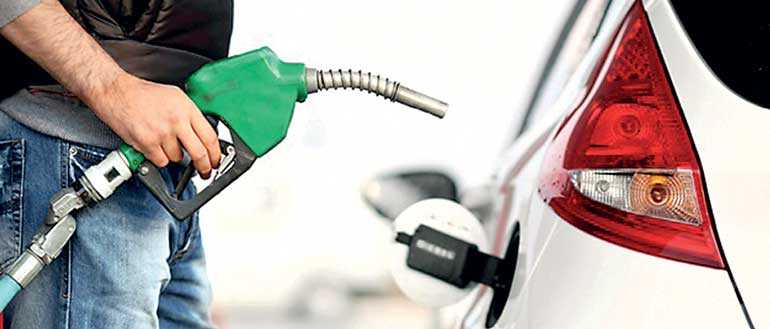Thursday Nov 27, 2025
Thursday Nov 27, 2025
Tuesday, 5 May 2020 01:09 - - {{hitsCtrl.values.hits}}

Government increases taxes on fuel to boost flagging public revenue
By Uditha Jayasinghe
Taking advantage of lower global prices, the Government has imposed a fresh round of import duties and surcharges on fuel, essentially doubling taxes, aimed at shoring up flagging public revenue.
The Finance, Economic and Policy Development Ministry, which is held by Prime Minister Mahinda Rajapaksa, has Gazetted levying an import duty of Rs. 50 per litre on all petrol imports, including 92 and 95 Octane as well as Rs. 25 per litre on all diesel imports. A second Gazette issued on the same day, 22 April, imposed surcharges of Rs. 26 on each litre of 92 Octane Petrol, Rs. 49 on 95 Octane, Rs. 40 on Super Diesel, and Rs. 24 per litre on other types of diesel.
The earlier duty had been held unchanged at Rs. 35 since late 2018 for petrol and there was no surcharge. For diesel, there was only a duty of Rs. 5.85, which was raised to Rs. 19.85 in March before being increased to Rs. 25 per litre in April. There was no surcharge for diesel earlier as well.
With the latest increases, taxes on a litre of petrol has increased from Rs. 59.26 to Rs. 104.81 and on diesel, from Rs. 26.66 to Rs. 57.82, according to the latest update by JB Securities. However, revenue from oil will be tempered due to the steep decrease in volumes due to the COVID-19 outbreak and the resultant curfew imposed by the Government as well as social distancing measures followed by many personal vehicle users.
“Fuel use in Sri Lanka has dropped by 80% since the start of countrywide curfew on 20 March,” Lanka IOC Managing Director Manoj Gupta told Daily FT. “In high risk areas, such as Colombo, Gampaha, Kalutara and Puttalam, fuel consumption has been even less than the 20% in other districts.”
“Even once curfew is lifted, there will be people who will maintain social distancing measures and not step out except for essential needs. We estimate that fuel use will remain 20-25% less than normal. In addition there will be much less long distance leisure travel and other types of consumption,” he said.
Government revenue declined to 12.6% of Gross Domestic Product (GDP) last year from 13.4% in 2018, largely on lower revenue collection from Value Added Tax (VAT), Cess and Ports and Airport Levy (PAL), according to the latest Central Bank Annual Report.
Public revenue took a further hit when the Government announced wide-ranging tax cuts last December and was also severely hit due to the COVID-19 outbreak. Rating agencies Fitch and Moody’s have forecast that Sri Lanka’s Budget deficit for 2020 could be 9% or higher and warned the Government is in danger of seeing its debt-to-GDP ratio rise to as much as 100% in the near term as it attempts to raise funds to reduce the deficit and repay debt.
Sri Lanka has to repay an estimated $3.2 billion between May to December this year. The Finance Ministry had estimated Sri Lanka’s Budget deficit for 2019 at close to 7%.
In April, US crude fell to an all-time low and traded negative for the first time on record while Brent hit a near-21-year low as the pandemic eroded demand.
Prices started to pick up last week after the Organisation of Petroleum Exporting Countries (OPEC) and other producers made record cuts to their production and reached a new supply deal that kicked in last Friday. This resulted in prices recovering somewhat to about $25 per barrel on Monday.
However, prices are unlikely to increase rapidly as setbacks to key industries, such as airlines and cruise-liners, are expected to continue for the rest of the year, and by some estimates, into the first quarter of 2021.
Experts have argued that tax adjustments to fuel is necessary as Government revenue struggles with the decline in exports and investment. Economists have also pointed out that lower fuel prices only benefit a selected group of society affluent enough to own vehicles while public revenue can be used to increase social welfare and reduce the cost of living burden on vulnerable communities.